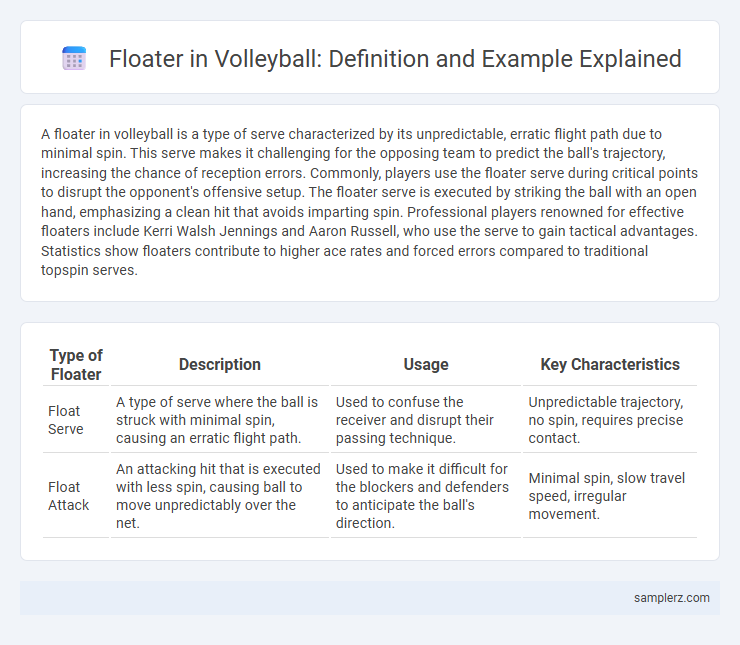A floater in volleyball is a type of serve characterized by its unpredictable, erratic flight path due to minimal spin. This serve makes it challenging for the opposing team to predict the ball's trajectory, increasing the chance of reception errors. Commonly, players use the floater serve during critical points to disrupt the opponent's offensive setup. The floater serve is executed by striking the ball with an open hand, emphasizing a clean hit that avoids imparting spin. Professional players renowned for effective floaters include Kerri Walsh Jennings and Aaron Russell, who use the serve to gain tactical advantages. Statistics show floaters contribute to higher ace rates and forced errors compared to traditional topspin serves.
Table of Comparison
| Type of Floater | Description | Usage | Key Characteristics |
|---|---|---|---|
| Float Serve | A type of serve where the ball is struck with minimal spin, causing an erratic flight path. | Used to confuse the receiver and disrupt their passing technique. | Unpredictable trajectory, no spin, requires precise contact. |
| Float Attack | An attacking hit that is executed with less spin, causing ball to move unpredictably over the net. | Used to make it difficult for the blockers and defenders to anticipate the ball's direction. | Minimal spin, slow travel speed, irregular movement. |
Understanding the Floater Serve in Volleyball
The floater serve in volleyball is a powerful technique characterized by a ball that moves unpredictably through the air due to minimal spin. Players execute this serve by striking the ball with an open hand, aiming to disrupt the opponent's reception and passing accuracy. Mastering the floater serve enhances offensive strategy by increasing serve variability and putting pressure on the opposing team's defense.
Key Characteristics of a Volleyball Floater
A volleyball floater is distinguished by its unpredictable, non-spinning trajectory that confuses opposing blockers and receivers. Key characteristics include a lack of spin, a knuckleball effect caused by striking the ball with minimal wrist snap, and a sudden drop or shift in direction mid-flight. This unique movement makes float serves and attacks effective tools for disrupting the opponent's rhythm and creating scoring opportunities.
Step-by-Step Guide to Performing a Floater
To perform a floater serve in volleyball, begin by positioning your non-dominant foot forward and holding the ball in front of you at waist height. Toss the ball slightly in front and upward using your non-dominant hand while swinging your dominant arm with a stiff wrist to strike the ball at its center, minimizing spin. Maintaining a firm wrist and following through straight ensures the ball floats unpredictably, making it difficult for opponents to receive.
Differences Between Floater and Topspin Serves
Floater serves in volleyball lack spin, causing the ball to move unpredictably in the air, making it difficult for receivers to anticipate its trajectory. In contrast, topspin serves generate a forward spin that results in a faster, more controlled ball with a distinct downward dip, increasing the chance of scoring service points. The floater's erratic motion contrasts sharply with the topspin's consistent spin, influencing the serving strategy and reception techniques during matches.
Mechanics Behind the Floater’s Unpredictability
The floater serve in volleyball gains its unpredictability from the lack of spin on the ball, causing erratic airflow that disrupts the receiver's timing. Small variations in finger placement and contact angle create turbulent air currents, making the ball's trajectory wobble and shift mid-flight. This mechanical principle leverages Bernoulli's effect and boundary layer disturbances to confuse opponents and reduce serve predictability.
Notable Players Known for Powerful Floaters
Karch Kiraly, often regarded as one of the greatest volleyball players, is renowned for his powerful floater serves that disrupt opponents' reception. Gabrielle Reece, a prominent figure in beach volleyball, utilizes a devastating floater serve that combines speed and unpredictability. Matt Anderson's signature floater serves have made him a formidable force in international volleyball competitions, consistently challenging blockers and receivers alike.
Common Mistakes When Attempting a Floater
Common mistakes when attempting a floater in volleyball include improper hand positioning, which can cause the ball to spin unintentionally and reduce the floated effect. Many players also fail to strike the ball at the center of their palm, resulting in inconsistent trajectory and less unpredictability for opponents. Insufficient follow-through and lack of wrist snap further diminish the floater's characteristic erratic movement, making the serve easier to receive.
Defensive Strategies Against Floater Serves
Defensive strategies against floater serves in volleyball require players to anticipate the unpredictable trajectory caused by the lack of spin, making positioning and quick reflexes essential. Teams often employ a platform-ready posture and emphasize communication to adjust rapidly as the ball changes direction mid-air. Training drills focused on float serves improve reception accuracy and reduce errors in serve receive formations.
Drills to Master the Volleyball Floater
Mastering the volleyball floater requires targeted drills such as the wall toss, where players practice releasing the ball with minimal spin to develop consistent float serves. Another effective drill involves partner passing, focusing on controlling unpredictable ball movement and improving reception skills under match conditions. Incorporating these exercises enhances players' ability to deliver and defend against float serves, optimizing in-game performance.
Benefits of Using the Floater Serve in Matches
The floater serve in volleyball offers unpredictable ball movement, making it difficult for opponents to accurately receive and control the ball. Its lack of spin causes sudden changes in trajectory, disrupting the timing and positioning of the receiving team. Utilizing the floater serve enhances service effectiveness and increases the chances of scoring direct points or forcing weak returns.

example of floater in volleyball Infographic
 samplerz.com
samplerz.com